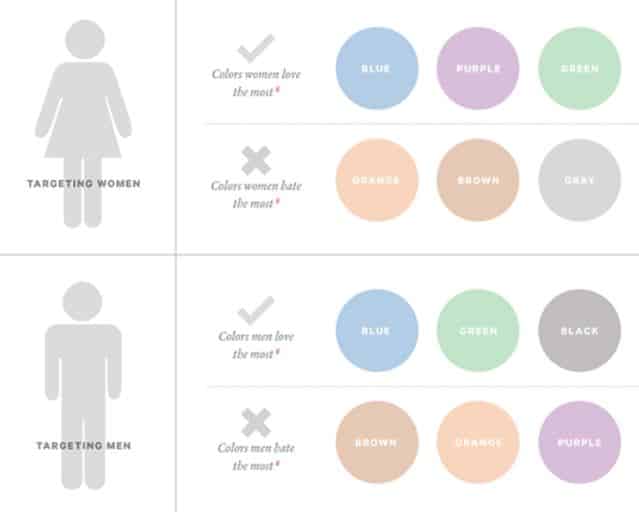What colour is your marketing? The psychological impact of colour
A recent post from ICEF Monitor touches on the impact of colour in marketing. It examines A/B testing, which involves an A version (the control) and a B version (the variation), with live traffic and the effect of each version makes on the rate of conversion can be measured. With A/B testing: “you can test different copy or colours on your homepage or the placement of a key conversion button or the subject line in your email campaign – or, for that matter, pretty much any aspect of your online presence.” In today’s post, we’ll revisit the topic of colour as an important factor in creating brand impact and helping prospective students form their initial impressions of an institution or school.
The meaning of colour
Colour psychology is a branch of science that concerns the affect colour has on human behavior. A KISSmetrics blog post by Jeremy Smith defines colour psychology:
“Colour wields enormous sway over our attitudes and emotions. When our eyes take in a colour, they communicate with a region of the brain known as the hypothalamus, which in turn sends a cascade of signals to the pituitary gland, on to the endocrine system, and then to the thyroid glands. The thyroid glands signal the release of hormones, which cause fluctuation in mood, emotion, and resulting behavior.”
Of course, colours have different meanings to various cultures, age groups, and nationalities. The KISSmetrics blog underlines that colour must be used in “the right way, at the right time, with the right audience, and for the right purpose,” and provides a broad characterisation of the psychological cues triggered by different colours:
- Blue denotes loyalty, sincerity, and trustworthiness as well as “calmness and serenity,” perhaps explaining why it is widely used both by major corporate or even national brands such as Facebook or the United States. Conversely, the online weight loss community Three Fat Chicks argues the colour blue suppresses appetite, suggesting it should be avoided when promoting food products.
- Yellow conveys warning (traffic signals, warning signs, and wet floor signage), or it can suggest happiness and fun.
- Green is the colour of the outdoors and the environment (it symbolises nature and is eco-friendly), and is also relaxing. Using the term “green” and the colour itself gives an environmental ambience to a website such as Friends of the Earth or Greenpeace, and clearly improves the reputation of such a company with environmental concerns. A blog post by Leo Widrich says green is “the most relaxing colour we can use to make buying easier.”
- Orange often denotes fun and creates a sense of impulse or haste. One view is that it stimulates “physical activity, competition, and confidence,” says Miss Details Design.
- Black adds an air of value and luxury or “elegance, sophistication, power,” according to the women’s health website Lifescript.
- White is often left out of colour psychology and there is debate as to whether or not it is classed as a colour – but the extensive use of white space “is a powerful design feature” – and an ever-more prominent feature of contemporary design in websites, print materials, and even products.
The following graphic illustrates some common gender responses to colour, including that women prefer hues such as blue, green, and purple. While men tend to prefer colours such as black, blue, and green, blue is clearly a very popular colour for both sexes.
We noted above that blue is widely used by major brands, due to its broad popularity and important psychological cues. However, if you are in a crowded colour space where competing brands are using a similar colour palette, you can also adopt an alternate colour mix as a means of breaking through the competition.
A recent study in the journal Color Research and Application points out that some newer brands are using the colour purple in place of the more standard blue to help them stand out from the competition.

What colour is your marketing?
What impact do the above and other colours have on the consumer? Research from Emerald Group Publishing finds that it takes only 90 seconds for a customer to form their initial impression about a product. A surprising percentage of that assessment – up to 90% in some cases – is based on colour, so the “prudent use of colours can contribute not only to differentiating products from competitors, but also to influencing moods and feelings – positively or negatively – and therefore, to attitude towards certain products.” In a journal article on the impact of colour in marketing, the University of Winnipeg’s Satyendra Singh adds:
“The wrong colour choice can have negative impact on the image of the product and the company. Global managers need to recognise that the different meanings associated with specific colours may facilitate multi-segment marketing opportunities.”
Cultural responses to colour
In a cross-cultural review of colour as a marketing cue the University of Wollongong’s Mubeen Aslam points out that colours can take on different meanings according to the cultural setting in which they are used. Harking back to the wide use of blue in corporate branding, for example, Mr Aslam’s research shows that blue is seen as cold (even evil) in East Asia, but represents warmth in the Netherlands, purity in India, and death in Iran. In the Netherlands it indicates femininity but, in the US and Sweden, masculinity. In spite of such differences in the perception of colour, Mr Aslam adds that colour conveys a corporate identity:
“For instance, blue stands for solid, responsible, financial services, green for innovative, caring organisations and yellow for young, bright, and exciting firms in the United States. Whereas blue is the corporate colour in the US, red is the winning business colour in East Asia.”
Mr Aslam says that colour is a vital aspect of corporate and marketing communications, because it “influences consumer perceptions and preferences, purchase and consumption behaviour, and helps companies (re)position or differentiate from the competition”, and that “a cross-cultural perspective of colour research and application is imperative for developing effective global marketing strategies, and the cultural values, marketing objectives and desired customer relationship levels would dictate the choice of colour in corporate and marketing communications in the 21st century.”
















